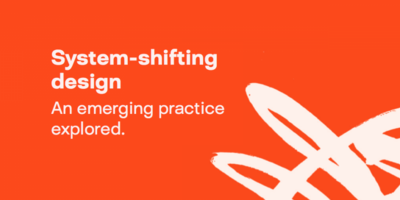Islington Clinical Commissioning Group

Islington Clinical Commissioning Group used design coaching to help them introduce personalised healthcare budgets to support an individual’s health and wellbeing needs.
Background
Islington Clinical Commissioning Group (ICCG) is made up of 37 GP practices and is responsible for commissioning £300m of healthcare services a year. Just under a quarter of a million people live in the north London borough of Islington – one of the most densely populated areas in the UK.
In the face of growing pressures on health and social care across the UK that traditional solutions are struggling to address, ICCG wanted to develop a more integrated approach to care within the borough.
We had an idea about the processes and systems we would need to deliver Personal Healthcare Budgets, we weren’t sure how best to package it.
Steven Pruner, NHS England
With growing acknowledgement that, in the past, many health and social services have been designed for ease of delivery rather than patient needs or wants – which has resulted in poor adoption – greater personalisation is now widely acknowledged to be the best way forward.
ICCG’s goal was to improve the experience of care by making the services it provides more personalised. One way it saw to do this was introducing Personal Healthcare Budgets: an amount of money to support an individual’s identified health and wellbeing needs, planned and agreed between that individual and their local NHS team.
“We had an idea about the processes and systems we would need to deliver Personal Healthcare Budgets, we weren’t sure how best to package it,” said Steven Pruner, Personal Health Budgets Regional Lead at NHS England. “What was missing was an understanding of how the new system would look, and the communications needed to explain it. Finding a way forward depended on effectively engaging with all of the stakeholders directly involved.”
Eager to find the best way to define the commissioning and delivery of the more personalised service it wanted to create, ICCG accessed support from Design Council.
What We Did
ICCG began working with Design Associate Colum Lowe whose first task was to bring together key stakeholders to discuss the issues and challenges in developing the service. As a crucial part of this, he took them through the principles of service design and the importance and value of a user-led approach.
“The idea was to bring all health and care-related budgets together and have just one point of contact for each individual patient, rather than many,” said Lowe. “Under the existing system, there was confusion among patients about the number of different people they have to deal with for different aspects of their support, and lack of clarity about cost as some services were free, some means-tested.”
While there was a clear understanding of the partners through which Personal Health Budgets would be delivered, there was more limited understanding of the users and how they should experience the service.
Colum Lowe, Design Council
Although there was general agreement on what was wrong with the existing processes, there was no consensus on the best way forward. Lowe facilitated a series of workshops for key stakeholders including clinicians, care workers and patient representatives. Participants were led through a discussion of issues and potential solutions.
“Workshops for key stakeholders are an important way to tease out ideas and encourage new ones through collaborative thinking and co-design. In this way, participants identify specific problems that need to be solved and a variety of ways forward,” said Lowe.
“For example, while there was a clear understanding of the partners through which Personal Health Budgets would be delivered, there was more limited understanding of the users and how they should experience the service. Putting the individual’s needs and wants at the heart of the process was key to delivering a seamless, holistic service.”
The interactive element of the process was really helpful in taking things from being abstract ideas to things we could actually try.
Sara Little, Islington Council
The process also helped the team understand how to take a public service problem and reframe it into a challenge where design could help shape the solution. Sara Little, ICCG’s Head of Programme Management Office explained, “The Design Associate’s approach was beneficial as a way for getting input about the solution from a range of different people at an early stage. The interactive element of the process was really helpful in taking things from being abstract ideas to things we could actually try”.
A recurring issue raised during the workshops was how best to communicate the process the patient goes through, and how to refer to it. An idea was then proposed to create a brand identity and brand communications materials for personal healthcare budgets, for which external design agency, Three&me was appointed. "The work completed by Design Council was extremely helpful towards defining the end user of the service. The planning undertaken has given us a good platform to take forward," said Three&me co-founder James Tye. The design team then produced a range of branded communication materials and guidance for how the brand identity should be used.
Results
Islington piloted Personal Health Budgets between June and December 2014 before the launch in April 2015. Since then, everyone in the borough has had the right to request one.
Pruner believes that Design Council’s support was invaluable in bringing together key stakeholders to unite around a single vision for moving forward. “We needed a third party to help all those involved visualise just what the new system would look like and how best to design it – not just for managers and providers but also the users,” he explained.
“By being independent and outside the system our Design Associate was able to gently guide discussions in a fresh direction – away from the areas where some people with strong views tend to focus – towards a new perspective. This was key.”
Subscribe to our newsletter
Want to keep up with the latest from the Design Council?

